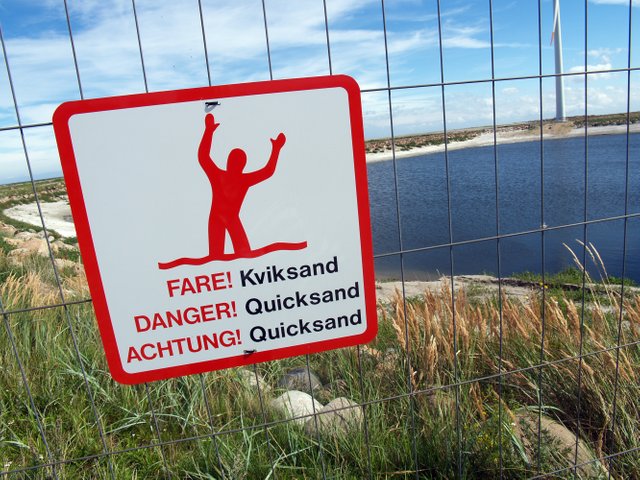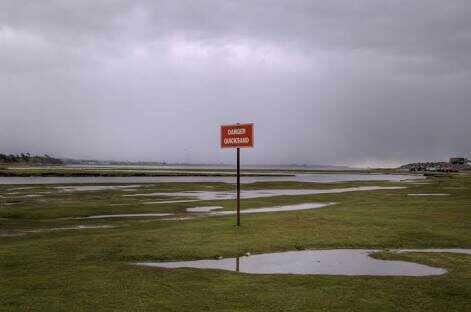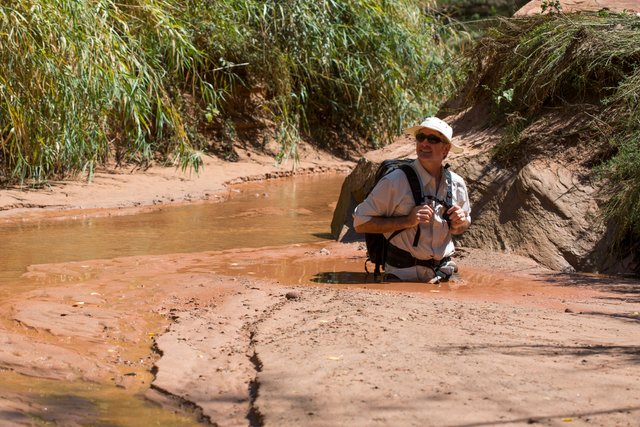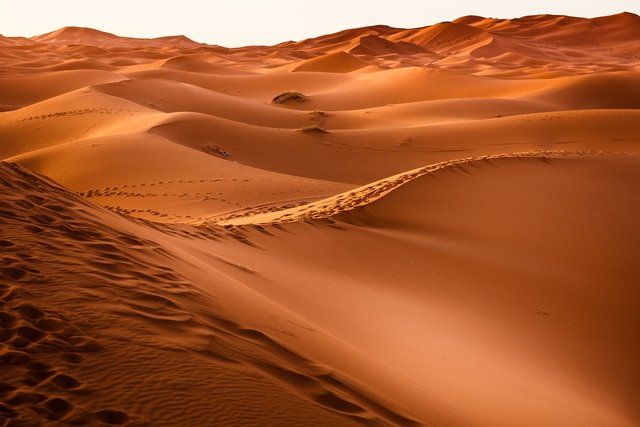Quicksand - When the earth becomes unable to support weight
Imagine taking a walk as authoritative as your step can be, only to take that unlucky step into a quicksand, now you are being swallowed by the earth, you tried taking a step out only to discover you sink further now, you call for help but no one could hear you, you remembered watching a movie which showed a scene of being drowned by quicksand, is this the end of the world for me? now hold it here......
I know that might feel like the worst expirence on earth, the feeling of death coming and you can do nothing about it anyway that's what the movies have made us to believe.
You might have seen our famous movie on archeology, Indiana Jones, or any other Hollywood movie which features a scene on quicksand, I bet after that you have the notion that an encounter with quicksand is a near death experience.
Now these questions might just be ringing through you :
What is a quicksand ?,
Where do quicksand exist? ,
Can one actually survive a quicksand?
By the end of this article, these and more will be made clear, so let's understand quicksand and how they work.
Quicksand
Quicksand is a combination of fine grains of sand, clay and water, it is known for its inability to support weight. The formation of quicksand can be explained by the sudden agitation of saturated loosed sand which forms a mixture where the water in the soil is unable to escape creating a soil without strength.

WikimediaStay our of danger zones byMatthew BargoLicenced under CC BY-SA 3.0
Quicksand have been known to form in both upward flowing waters and standing waters, when in the case of upwards flowing water, the water tend to suspend the particles of soil in the area.
When in such state, the sediment may appear to the eyes to be of a solid nature up until there is a slight change in the pressure due to force or shock thus causing liquefaction of the area making the saturated sand loose strength. The water inherent in a quicksand give it a texture which is in form of a fluid and any object which find its way into such will sink up to a level where it's weight becomes equal to the weight of fluid.
Quicksand occurrence can be anywhere in as much as there is a presence of loose sand water and a form of agitation, the following conditions can tend to aid the formation of quicksand:
The Presence Of Underground Water: This situation is a very likely condition for the formation of quicksand, this is a situation where an underground water tend to flow up through a loosed sand hence getting around each grain of sand, the friction which exist between these grains is lost thus a suspension is formed.
Vibration : vAny form of vibration of the soil, an earthquake for example can lead to an increase pressure of underground water hence leading to the liquefaction of silt and sand causing them to loose strength, this now look like solid but when a buoyant object falls from the top, it tends to sink through.

Flickr Image By DaveBleasdale: They occur in the presence of a water body
Places where the formation of quicksand is more prevalent are around lakes, Riverbanks, marshes, near underground Springs and Riverbanks, so it's advised that when taking a walk through these areas, you should be at alert to avoid any encounter with a quicksand.
I for once wouldn't want an expirence with quicksand, though disgusting it might cause death , though not mostly by drowning in it, lets continue with the learning and it's time to know some untrue on quicksand.
Untrue Beliefs About Quicksand
Just like we have described this to be a condition of an area, over the years we have been made to believe so many things about quicksand mostly with regards to watching movies and reading, in this section I will clear the smoked air about quicksand , stating some myths on quicksand which many might till now still belive to be true, let's kick off.
Quicksand Sucks You Down Till You Drown

Wikimedia: In a quicksand by AlbertHerring Licensed under CC BY-SA 2.0
Movies bearing a scene on quicksand got it all wrong when it comes to this aspect. Unlike what the movies have led us to believe, you don't actually get sucked up by a quicksand but just like every other liquid, you can sink in a quicksand up to an extent but due to its thick nature. There might be an amount of resistance, mostly when wearing a boot or a flat soled shoe.
What about when carrying a heavy load?
When carrying a heavy load just like a backpack, it tend to make you less buoyant hence causing a sink up to the chest level or say up to the shoulder level, this sink level of quicksand is due to the fact that quicksand is less dense than liquids like water making floating more easier than water canceling the possibility to sink completely to an extent.
Quicksand Is A Living Body
With how nature made it, more so it's name "quick-sand" which gives it the attribute of a living thing many might have the notion that it might actually be a living sand or something.
Also, this notion might also come from its feature of changing from what looks like a solid to a semi-liquid when stepped in, hence giving the idea that the ground might have just come to life, hello, it's simple physics. Accompanying this is that which say that some living things like the worm, and leaches have their abode to be quicksand which is not true since the quicksand is very wet for most worms and solid for leaches to survive.
Leaches are known to be mostly found in muddy or stagnant water and since quicksand is mostly found in areas of moving waters a quicksand is less likely to be home for these creepy animals.
You Are Stuck And Unable To Move
When we refer to a quicksand, we are not actually talking about a magical suction device which will grip you and keep you stuck just like we watched in the movies. Getting into a quicksand sinks you to an extent but because you float in a semi solid or semi liquid which have no ground strong enough to pull you out.
You Just Fell Into A Bottomless Part Of The World
Are you amongst those having the idea of quicksand being bottomless, time to have a rethink, although there exist areas of very deep quicksand as other might range from few inches deep and areas where they can be quite deep but there is actually an end to it.
Very huge amount of water pressure underneath is needed for the formation of very deep quicksand so steeping into a quicksand is not as dangerous as it is portrayed to be but you can bet it to be a disgusting and embarrassing expirence.
Quicksand Is Mostly Found In Deserts
Amongst the mistake made by many is belive that quicksand is mostly found in the desert, that's wrong though. Quicksand is naturally formed with the presence of molecules of water.
We move on a solid ground, though sometimes contains liquids but these are not enough to surround the grains of sand hence they can move against themselves bringing about friction between them and hence a solid feeling.
Imagine these grains of Sands are not soaked in water completely now having no contact between them they tend to become gel like, hence the formation of a quicksand needs water which is rearly found in the desert.
The Concept Of Dry Quicksand ?
Have you heard of the dry quicksand? Just as the name goes, this is a phenomenon in which a dry sand becomes unable to support weight.We have seen that which is the combination of sand clay and water, but the dry quicksand do not contain any form of water and scientists have termed this occurrence deadly than regular quicksand.
In a sand, weight is supported by chains of forces through the sand, a dry quicksand would be formed if in any way these chains of forces are weakened by any means, a good means of reducing this chains of forces is by the action of air passing through the fine sand, after this action and the sand is now settled it becomes unable to support weight.
The dry quicksand should not be in any way confused with the common quicksand which is the combination of clay, sand and water. However, the concept of dry quicksand have only been proved in the laboratory and an occurrence have not been seen in the wild, but the existence of this in the wild have not been cancelled by scientists.
Surviving Quicksand
Avoid Falling Into One
First things first, the best way to survive a quicksand is to not fall in one and this can be achievable in a lifetime, I will highlight some tips to put in place when taking a walk so as not to get into this mess.
Identify Danger Zones: when you are walking through any form of wet terrain, most especially near swamps, tidal flats, Riverbanks, glaciers an underground spring, it's important to always stay alert for any form of changes in the soil texture or any sign indicating a quicksand closeby, most especially after a heavy rainfall.
If there is a bubble of water from underneath the ground as you took a step you most likely have stepped on one, a ripple appearance can also be an indicator. In such areas, you should be careful when walking to avoid telling a story afterwards
Test Ground With A Trekking Pole : What better way to know if a quicksand is in front of you than to test the ground before you take a step, when walking through places where quicksand might likely be found its advised to walk with a walking stick or a trekking pole with which you can use to test the ground for any formation of quicksand, on seeing one, step back and take another route to your destination.
Getting Out Of A Quicksand
Unlike what many must think that survival from a quicksand is actually impossible, that's not true. In a quicksand, a struggle through it might actually cause you to sink further to an extent so being relaxed in such occurrence is a key to survival.
The density of the human body is such that it can float on water, quicksand is a lot dense then water hence the possibility of floating in a quicksand is higher than floating on water, though the ratio of sand to water can vary based on the location of the quicksand making some to be more buoyant than others but you should bear in mind that survival is certain if you do the right thing.
The first thing to do in this situation is to free yourself from any extra load on you, for example, a backpack, unstrap it as this may tend to increase your weight making you to sink further than your body weight should in the quicksand. Standing still will only sink you down to the waist but a heavy weight on you or threshing the water around will separate the water causing you to sink further probably to your chest.
The next thing to do is to take a lean backwards with your hands finding any drysand at your back which might help pull you out, if you can find one, no need to worry. Leaning backwards should be with your back lying on the quicksand, if you are with any trekking stick it should come to use now, keep the trekking stick at your back when leanning backwards as this will help stabilize your body, though this might be a scary part to achieve, you need not to worry as you will float in the quicksand if you do not make any kind of sudden movement.
Just like I stated, quicksand is more dense than water hence a greater possibility of floating when compared to water.
Now it's time to gently bring your legs from the quicksand upwards. This should be done in a slow mood, no rush, you have all the time you need to get out of this mess. With your back floating on the quicksand, bringing the mid section of your legs to float on the quicksand won't be a problem.
Time to get out of the mess, now on your current leaning position, using your hands slowly take short strokes towards the edge of the quicksand, this is called a backfloat and mind you, it should not be the regular backstroke swimming, doing this, do not submerge your hands into the quicksand and try not to paddle with the entire arm as doing that at a rate will tend to separate the mixture around you which will only lead to decrease in your buoyancy and that's not good for our escape.
Paddling your way out may take few hours, that souly depend on how far into the quicksand you are, just take it slow, it's good to take breaks and stare into the sky when you feel tired, that should be if you are not in a tidal or dangerous areas as death by quicksand have been known to not be caused by the quicksand but other external factors in the environment such as being drowned by tidal flow of water in the area.
When close to the edge and you now have a good grip of land, pulling out yourself might be a bit difficult since your legs are submerged in it, the quicksand may act as a vacuum producing a section effect, in this situation try getting your shoes off using a stick as flat shoes are known to cause a great deal of suction effect in a quicksand, now pull yourself out bit by bit.
Pulling out your shoes should not be done with your hands, so in a situation where you can't find a stick but you have your hands on something strong on the ground a method which works is to move your body in a circular manner which will help in separating the water and grains of sand around you creating a pool of water around which would enable you out when pulling bit by bit until you are fully out of the quicksand.
Bringing It All Together
Though not as dangerous as they might have shown it in the movies , I won't want to have an expirence with quicksand and I know you won't too. The dangers of getting stuck in a quicksand is not the quicksand actually but the dangerous environment you might be, most especially in tidal areas which might lead to drowning before you can be able to save yourself. I have stated all you need to avoid a quicksand experience, its better avoided than experienced but when it comes to the worst of getting stucked in a quicksand, the tips above might just come in handy.
Another important safety precautions is not to walk alone in areas suspected to be prone to quicksand formation, going in a group is advised as others can serve as a good aid for survival.
The dangerous is the dry sand which have only been shown in experiments but have not been found in the wild, though there is the belive that such exist in the wild, so if you take a walk through a desert, I will advice you be cautious of the ground you walk as an encounter with dry sand might just get you lost for life.
Until next time, stay cool.


Movies have a way to make myths to appear as if they are real. This is how they made us think that if someone should pour petrol on a car and the area surrounding the car, and then throw a lit cigarette on the petrol poured on the floor, it will cause the car to catch fire. I recently learnt how untrue that theory is. I have always thought that quick sand can literally bury someone alive, am glad you just corrected that notion. Great article @logic42
Will you blame them, anything to make the movie a hit. In a quicksand you float with respect to your weight and the weight of the liquid and due to the mixture of sand silt and water, chances of floating is higher.
Watched so many of that I can't count, thanks for adding that, anyway it's quite fun to watch sometimes.. now you met a movie freak